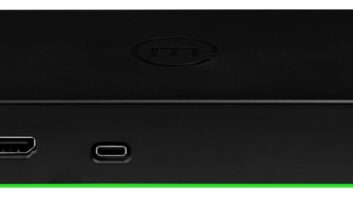Audio/video receivers (AVRs) are aggressively adopting new technologies to tap into demand for wireless-multiroom audio, movie soundtracks mixed in object-based surround formats, 4K Ultra HD home theaters, and high-dynamic-range video sources.
Sister brands Pioneer and Onkyo are bringing wireless-multiroom audio for the first time to their AVRs, joining Yamaha and Sony. The capability will be available with a firmware upgrade for new Onkyo AVRs priced down to a suggested $599 and for new Pioneer AVRs starting at a suggested $500. In its 2016 lineup, Yamaha will continue to start wireless multiroom audio at $449.
Object-based surround decoding, meantime, is becoming available at lower price points from more companies, with Pioneer adding a DTS:X upgrade option to its new $500 and $700 Atmos-equipped AVRs. Pioneer previously offered DTS:X-upgrade capability only on three Atmos AVRs at significantly higher prices of $1,600, $2,000 and $2,500. In its 2015 line, Pioneer also offered $600-and-up Atmos AVRs that couldn’t be upgraded to DTS:X.
For its part, Onkyo is bringing AVRs with Atmos and DTS:X upgradability to $599, down from last year’s $699. Last year Onkyo also offered a $499 Atmos AVR that couldn’t be upgraded to DTS:X.
With its launches, Yamaha is bringing Atmos and on-board DTS:X for the first time to its RX-V series of low- to mid-priced AVRs, starting the surround formats at $549. The AVRs won’t require a firmware upgrade to add DTS:X.
In its 2015 lineup, Yamaha offered Atmos only in its step-up Aventage series, which started Atmos at $999 and DTS:X upgradability at $1,299.
For 4K home theaters, lower priced AVRs will continue to offer 4K-capable HDMI 2.0 inputs and outputs with HDCP 2.2 copy protection. HDR-capable HDMI 2.0a connections, however, will continue to spread, with Yamaha bringing HDMI 2.0a down to $299. Yamaha previously offered HDMI 2.0a only as a firmware upgrade starting at $649 in the RX-V series and at $549 in the Aventage series. The HDMI 2.0a firmware updates for those AVRs became available March 30.
HDMI 2.0a enables passthrough of HDR 10 content. Dolby Vision HDR content is already compatible with HDMI versions going back to 1.4b.
For its part, Pioneer is offering HDMI 2.0a out of the box on its new $499 and $699 AVRs, having offered models starting at $399 with 2.0a upgrade capability. The 2.0a firmware upgrades became available last August.
Here’s what the companies are up to:
Onkyo: In unveiling seven AVRs priced from $399 to $1,299, Onkyo said it plans summertime availability of firmware upgrades to add Google Cast, Tidal and wireless-multiroom audio to six of the models starting at $599.
The new AVRs include the $399 TX-SR353, $599 TX-NR555, $699 TX-NR656, and $799 TX-NR757. The new models also include these RZ series models: $799 TX-RZ610, $999 TX-RZ710, and $1,299 TX-RZ810. Shipments of all models are planned for April and May.
All of the AVRs but the $399 model feature Atmos, and the Atmos models will get a summertime firmware update to add DTS:X. The Atmos/DTS:X models feature 7.2 channels to support 5.2.2 speaker configurations but won’t drive 5.2.4 or 7.2.2 speaker configurations if connected to an add-on two-channel amp.
Onkyo’s planned wireless-multiroom upgrade will add wireless technology developed by BlackFire Research, which also developed the wireless-multiroom technology in new Pioneer AVRs and in Harman Kardon’s current and planned wireless tabletop speakers. Although the Onkyo and Pioneer products will interoperate, Onkyo said it “cannot confirm interoperation with other manufacturers’ products.”
Onkyo and Pioneer also plan to offer tabletop wireless speakers incorporating Blackfire.
Also with the Onkyo launches, HDR-capable HDMI 2.0a inputs with HDCP 2.2 copy protection continue to start at a suggested $399, built-in Bluetooth continues to start at $399, and built-in Wi-Fi, DLNA, and AirPlay continue to start at $599.
Pioneer Home Entertainment: The Elite series VSX-LX101 and VSX-LX301, priced at a suggested $500 and $700, respectively, are the brand’s first announced AVRs to offer wireless multiroom audio, Google Cast, and Tidal streaming. Those capabilities will be available with a firmware update later this year. The AVRs themselves will be in stores in April.
Fall is the timeframe for a firmware update to add DTS:X to the two Atmos-equipped AVRs.
The AVRs’ wireless-multiroom technology was developed by Blackfire Research, which also developed the wireless-multiroom technology in 2016 Onkyo AVRs.
Both 7.2-channel AVRs support 5.2.2 speaker configurations but don’t accept add-on amps to drive 5.2.4 or 7.2.2 configurations.
The two AVRs feature built-in Bluetooth, Wi-Fi, DLNA, AirPlay, and HDR-capable HDMI 2.0a inputs and outputs with HDCP 2.2 copy protection.
Both models are also the brand’s first to offer Reflex Optimizer technology to optimize the sound delivered by upward-firing Atmos elevation speakers.
Yamaha: In launching five RX-V series AVRs, the company is bringing HDMI 2.0a connections down to a suggested $299 in the opening-price RX-V381.
The four other AVRs are the $849 RX-V781, shipping in June; $649 RX-V681 and $549 RX-V581; shipping in May; and the $449 RX-V481, shipping in April.
Of the five, three models starting at $549 feature Atmos/DTS:X. These 7.2-channel models support 5.1.2 speaker configurations but won’t support 5.1.4 or 7.1.2 speaker configurations when a two-channel amp is added.
Like last year, DNLA networking, AirPlay, and built-in Wi-Fi start at a suggested $449, as does Yamaha’s proprietary MusicCast wireless multiroom-audio technology.
In one change, two RX-V models get a phono input for the first time.
The company also added dialog-level adjustment to all of the models, enabling users to increase dialog volume.












